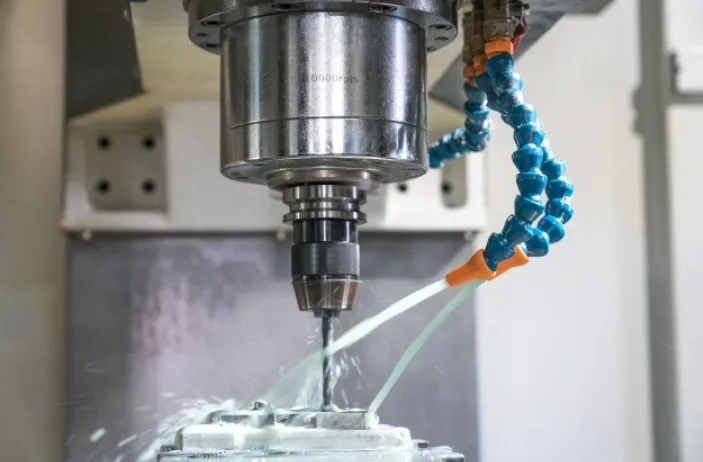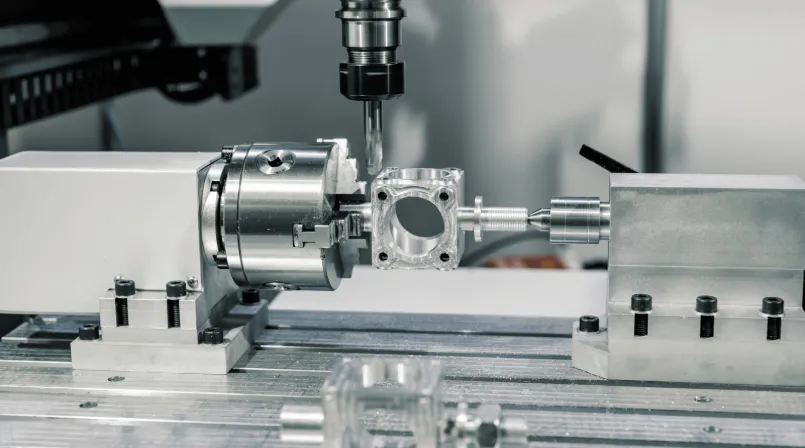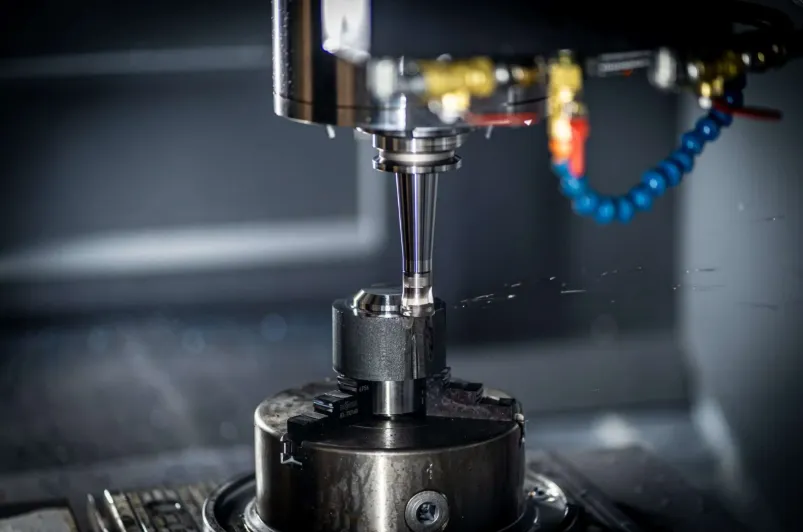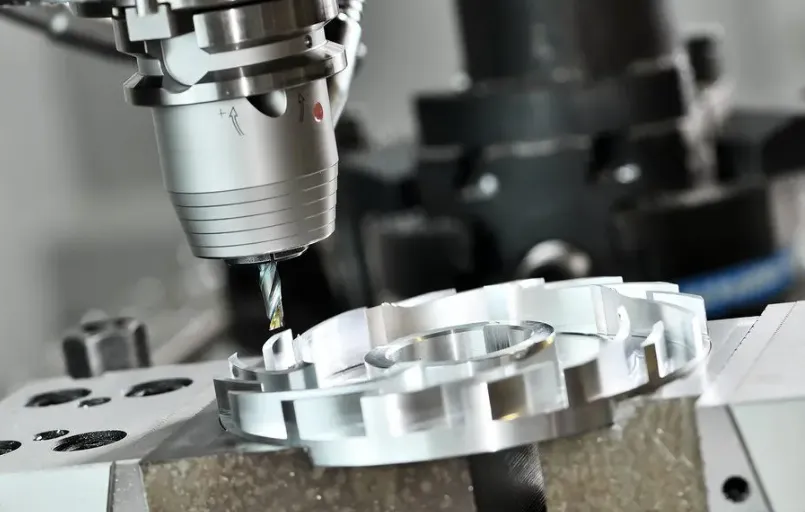Machine Frame and Structural Components
Metal milling machines feature heavy-duty construction utilizing cast iron, welded steel, or polymer concrete for optimal vibration damping and rigidity. The base structure incorporates precision-ground ways or linear guide rails that support the movement of the X, Y, and Z axes, with larger industrial models often including additional axes for enhanced functionality. Box-way designs provide maximum stability for heavy cutting operations, while linear guide configurations offer smoother high-speed movement. The column and knee assembly in vertical mills maintains precise perpendicularity to the table, typically within 0.02mm over 300mm travel. Industrial-grade machines weigh from 1,000 kg for benchtop models to over 10,000 kg for large floor-standing units, with the mass directly contributing to vibration resistance during aggressive material removal.
 Spindle Systems and Tool Interface
Spindle Systems and Tool Interface
The milling machine spindle represents the core of its metal removal capability, with configurations varying by machine type and intended application. Standard vertical spindles range from 3 kW for general purpose machines to 30 kW for heavy-duty production models, with speed capabilities spanning 50-15,000 RPM. Taper interfaces include CAT, BT, and HSK designs, with drawbar mechanisms providing up to 10,000 N of retention force. High-precision angular contact bearings maintain spindle runout below 0.005mm TIR, while advanced models incorporate hydrostatic or magnetic bearing systems for ultra-precision applications. Automatic tool changers with capacities from 12 to 120 tools reduce non-cutting time between operations, with tool-to-tool change times as fast as 0.8 seconds on high-performance machines.
Axis Drive and Motion Control Systems
Modern metal milling machines employ AC servo motors with absolute encoders for precise axis positioning, typically achieving resolutions of 0.001mm or better. Ball screws with preloaded nuts eliminate backlash, while linear scale feedback systems on premium machines provide closed-loop positioning accuracy within ±0.005mm. Rapid traverse rates range from 15 m/min on conventional machines to over 60 m/min on high-speed models, with acceleration capabilities exceeding 1G in some cases. The control system dynamically adjusts feed rates based on spindle load monitoring, preventing tool overload during varying cutting conditions. Advanced look-ahead processing (200-1000 blocks) ensures smooth motion during complex contouring operations at high feed rates.
Worktable and Fixturing Options
The milling machine table provides a rigid platform for workpiece mounting, with standard sizes ranging from 400x800mm to 1,500×3,000mm in large gantry mills. Precision-ground T-slots (typically 12mm, 14mm, or 18mm) accommodate various clamping systems, while the table surface maintains flatness within 0.01mm/m. Optional rotary tables add 4th axis capability for complex machining, with direct-drive models offering positioning accuracy within 15 arc seconds. Modular fixturing systems allow quick changeover between jobs, while vacuum chucks and magnetic workholding provide alternatives for thin or non-ferrous materials. The table load capacity varies from 300 kg for smaller machines to over 10,000 kg for heavy-duty models, with some featuring automatic pallet changers for uninterrupted production.
Coolant and Chip Management
Effective coolant systems are critical for metal milling operations, with configurations tailored to specific applications. Flood coolant systems deliver 20-100 liters/minute through adjustable nozzles, with multi-stage filtration removing particles down to 10 microns. High-pressure through-spindle coolant (up to 70 bar) improves chip evacuation in deep cavity milling, while minimum quantity lubrication (MQL) systems reduce fluid consumption in environmentally sensitive applications. Chip conveyors automatically remove swarf from the work area, with options for separating different metal types for recycling. Enclosed machines often incorporate mist collectors and oil skimmers to maintain coolant quality and reduce airborne contaminants.
Control Systems and Programming Interface
CNC controls for metal milling machines have evolved into sophisticated computer systems with advanced functionality. Industrial PC-based controllers run proprietary or open architecture software, featuring 15-21″ touchscreen displays with graphical toolpath simulation. Standard programming methods include:
- ISO G-code programming
- Conversational programming interfaces
- CAD/CAM system post-processing
- 3D simulation and verification
Network connectivity through Ethernet, USB, and wireless options facilitates program transfer and remote monitoring capabilities. Many systems now incorporate adaptive control algorithms that automatically optimize cutting parameters based on real-time spindle load and vibration feedback.
Tooling Systems and Accessories
Metal milling requires an extensive array of cutting tools, each designed for specific operations and materials. Common tool types include:
- Solid carbide end mills (2-4 flutes)
- Indexable insert face mills
- Drills and boring tools
- Thread mills and form cutters
- High-feed mills and chamfer tools
Tool holders range from basic collet chucks to precision hydraulic or shrink-fit systems that minimize runout. Automatic tool presetters measure tool geometry offline, with data transferred directly to the machine control. Additional accessories like probing systems, tool breakage detectors, and workpiece measurement devices enhance the machine’s capabilities and reduce setup time.
Material Compatibility and Cutting Parameters
Metal milling machines process a wide range of materials, each requiring specific approaches:
- Aluminum alloys: 500-3,000 m/min cutting speed
- Steel alloys: 100-300 m/min cutting speed
- Stainless steel: 50-150 m/min cutting speed
- Titanium alloys: 30-80 m/min cutting speed
- Hardened steels (45-65 HRC): 50-120 m/min cutting speed
Depth of cut varies by material and tool diameter, with roughing operations typically using 0.5-1.5× tool diameter and finishing operations employing 0.05-0.2× tool diameter. Modern toolpath strategies like trochoidal milling and high-efficiency machining (HEM) optimize material removal rates while extending tool life.
Accuracy and Performance Verification
Metal milling machines undergo rigorous testing to verify their performance capabilities. Standard tests include:
- Positioning accuracy and repeatability (ISO 10791)
- Circular interpolation tests (NAS 979)
- Volumetric accuracy verification
- Spindle runout and thermal growth analysis
- Surface finish capability assessment
These tests ensure the machine meets its published specifications before being put into service. Regular calibration maintains accuracy over the machine’s operational life, with laser interferometers and ballbar test equipment used for periodic verification.
Safety Features and Operational Protocols
Modern metal milling machines incorporate comprehensive safety systems:
- Interlocked sliding doors with safety-rated sensors
- Emergency stop circuits with redundant monitoring
- Spindle overload protection
- Axis limit switches and soft limits
- Tool breakage detection systems
- Vibration monitoring for collision detection
Operational protocols require proper workpiece securing, tool length verification, and clearance checks before program execution. Proper training ensures operators understand both machine capabilities and potential hazards associated with metal milling operations.
Maintenance Requirements and Service Life
Proper maintenance extends machine life and maintains accuracy. Key maintenance activities include:
- Daily: Way lubrication checks, chip removal
- Weekly: Coolant concentration verification, hydraulic pressure checks
- Monthly: Ball screw lubrication, electrical connection inspection
- Quarterly: Way cover cleaning, axis alignment verification
- Annual: Spindle bearing regreasing, complete system calibration
With proper maintenance, a quality metal milling machine can provide 15-20 years of productive service, though spindle rebuilds and control upgrades may be required during this period.
Industrial Applications and Use Cases
Metal milling machines serve diverse industries:
- Aerospace: Structural components, engine parts
- Automotive: Engine blocks, transmission cases
- Medical: Implants, surgical instruments
- Mold and die: Cavity sinking, electrode machining
- Energy: Turbine components, generator parts
- Defense: Weapon systems, armored vehicle components
Each application demands specific machine configurations and tooling solutions to achieve the required results efficiently.
Economic Considerations and ROI Factors
The total cost of ownership for metal milling machines includes:
- Initial purchase price ($50,000-$500,000+)
- Installation and facility preparation
- Tooling and workholding investments
- Operator training
- Ongoing maintenance and energy costs
Return on investment calculations must consider:
- Machine utilization rates
- Labor cost savings
- Scrap reduction
- Improved part quality
- Production flexibility
High-volume production environments often justify more expensive machines through increased throughput and reduced per-part costs.
Technological Advancements
Recent innovations in metal milling include:
- Smart machines with integrated process monitoring
- Additive/subtractive hybrid capabilities
- AI-powered tool wear prediction
- Advanced thermal compensation systems
- Energy-efficient drive systems
- Cloud-connected performance analytics
These developments continue pushing the boundaries of metal removal rates, precision, and process reliability.
Comparison with Alternative Processes
Metal milling offers distinct advantages compared to other manufacturing methods:
- Higher accuracy than manual machining
- Greater material versatility than turning
- Better surface finish than EDM for many applications
- More efficient material removal than grinding for bulk operations
- Greater design flexibility than casting or forging
The process remains fundamental to metal part production across industries despite the availability of alternative technologies.
Future Outlook
The metal milling industry continues evolving toward:
- Increased automation and lights-out operation
- Tighter integration with manufacturing systems
- Improved energy efficiency
- Enhanced material removal rates
- More sophisticated process monitoring
- Greater use of simulation and digital twins
These trends will ensure metal milling remains a cornerstone of precision manufacturing for decades to come.








